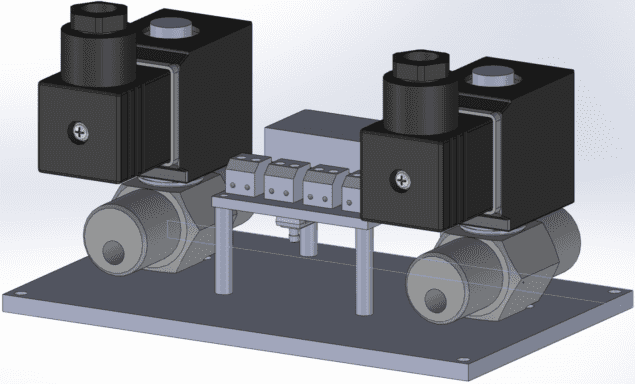
Members of the DarkSide experiment at the Gran Sasso National Laboratory in Italy have temporarily put their hunt for dark matter on hold in an attempt to stem the deadly tide of COVID-19. The 26-strong group of physicists from Europe and North America has designed a new, stripped-down mechanical ventilator that it hopes can be mass-produced quickly and cheaply using off-the-shelf components. Liaising with medical professionals and calling on the expertise of fellow physicists, the researchers aim to produce a prototype device today or tomorrow (27–28 March) and then work flat out to try and get the device into hospitals as soon as possible.
Many of the most seriously ill patients infected with COVID-19 develop pneumonia and need assistance-breathing. That is done using mechanical ventilators, which pump oxygen into the lungs and then remove the carbon dioxide that they breathe out. This is a delicate process that involves regulating the pressure and/or volume of oxygen provided. It can be done either fully automatically on a sedated patient, or to support a patient’s natural breathing.
The new ventilator design has been spearheaded by Cristiano Galbiati, a physicist at Princeton University in the US, and the Gran Sasso national lab, which is run by Italy’s National Institute for Nuclear Physics (INFN). Currently locked down in Milan, Galbiati says that he started working on the design after speaking to a friend on 19 March whose family had made a big donation to an intensive-care hospital rapidly being assembled on the site of Milan’s Expo in 2015 to treat some of Italy’s ever-growing number of coronavirus patients. The friend told him that a consignment of ventilators supposed to be arriving from Germany had been cancelled. “That is when I realized that we need to do something different,” he says.
Mechanical Ventilator Milano
Galbiati quickly brought together colleagues from DarkSide, and using criteria published by the Medicines and Healthcare products Regulatory Agency in the UK, which stipulate the essential features for any new design of ventilator, came up with a blueprint entitled Mechanical Ventilator Milano (MVM). This, he says, is inspired by a 1961 design from Roger Manley of Westminster Hospital in London, which was “basic but very reliable” – one of the main differences being that the new machine will use electrically driven pneumatic valves rather than mechanical switches.
According to Galbiati, the MVM would be compact and require fewer parts than most ventilators on the market today. Its simplicity, he says, derives from the fact that it controls the pressure of oxygen in a patient’s lungs using two fail-safe valves in the form of vent traps – nothing more than columns of water or oil with a specific depth. One trap positioned upstream from the patient ensures a certain maximum pressure during inhalation and another, downstream, dictates the minimum pressure following exhalation.
Unlike more sophisticated ventilators, the MVM would not be able to regulate the volume of oxygen in someone’s lungs (as opposed to the pressure). Galbiati says that he does not know how strictly necessary it is to be able to control both quantities but is nevertheless convinced that the new design would be a life-saver in Italy’s heavily infected Lombardy region and beyond. “I can’t say what is needed in most cases,” he adds. “But what I can say is that there are patients who get no treatment. A mechanical ventilator that only has only pressure control will still be very valuable.”
Laboratory tests
On 20 March, Galbiati and colleagues carried out a first set of tests in a laboratory near the hard-hit city of Bergamo using some of the components of the MVM and a standardized test lung made from a silicone bag. Then on Monday, they uploaded a pre-print on arXiv outlining their design and asking scientists and medics for feedback in order to “speed the process of review, improvement and possible implementation”.
Galbiati says that the first prototype device should be ready as soon as 27–28 March, but adds that developing the machine itself is not that difficult. The main outstanding technical challenge, he says, is producing the software that runs the device. “We have shifted the complexity to the controller and design software,” he explains. “This is something that particle physicists excel at. But if we want to do it quickly, we need the collaboration of the best programmers from the strongest particle physics labs.”
Heading up the effort on the other side of the Atlantic is Art McDonald of Queen’s University in Canada, who shared the 2015 Nobel Prize for Physics for the discovery of neutrino oscillations. McDonald says that he has been “mobilizing resources” from several Canadian particle and nuclear laboratories, including electronics expertise at TRIUMF and mechanical engineering skills from Chalk River Laboratories and SNOLAB. Together with Galbiati, he has also been drumming up support from Fermilab in the US and CERN in Switzerland.
McDonald says that he has had “excellent feedback” on the MVM from medical experts, including those in a group at McGill University in Quebec who are overseeing ventilators in Canada. Although Italy has not yet given formal regulatory approval for the design, he says that informally, authorities have sent very encouraging signals (indeed, Galbiati says that they have granted special permits to re-open factories for the production of necessary items). McDonald is also hopeful that approval will be soon be given in Canada, having spoken to “authorities at the highest level” there.
The biggest remaining question, McDonald says, is whether industry can produce the machine quickly enough to really limit the damage done by the virus in Italy and elsewhere. “I don’t know the answer to that yet,” he says. “But we have a lot of very highly motivated individuals working on this.”
Edwin Cartlidge is a science writer based in Rome
Analysis: can physicists help solve the ventilator shortage?
By Hamish Johnston
As the novel coronavirus continues, its relentless spread across the globe, more hospitals are facing shortages of ventilators and other key equipment and supplies. It is only natural that physicists want to apply their technical skills to creating new ventilator designs that can be quickly manufactured. And it is not just physicists, engineers at companies that supply of a wide range of products from vacuum cleaners to nuclear technologies have joined the effort.
However, these projects face huge challenges. In some places, ventilators are needed right now, yet new devices must go through stringent testing to be approved for use. Also, will it be possible to train already busy intensive-care staff to use the devices and would they have confidence in the new technologies?
Regardless of whether these new ventilators are used on COVID-19 patients, scientists and engineers should be lauded for their efforts. And as often happens in science, there could be spin-off applications of the new ventilators such as use in developing countries where simple and accessible medical equipment is needed.



